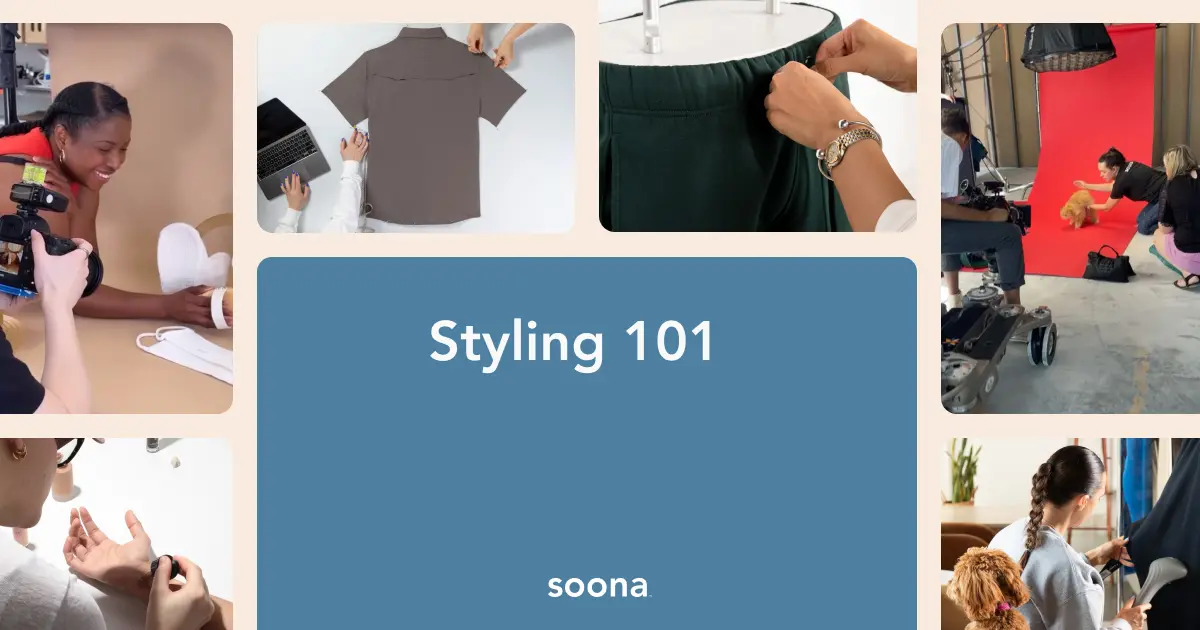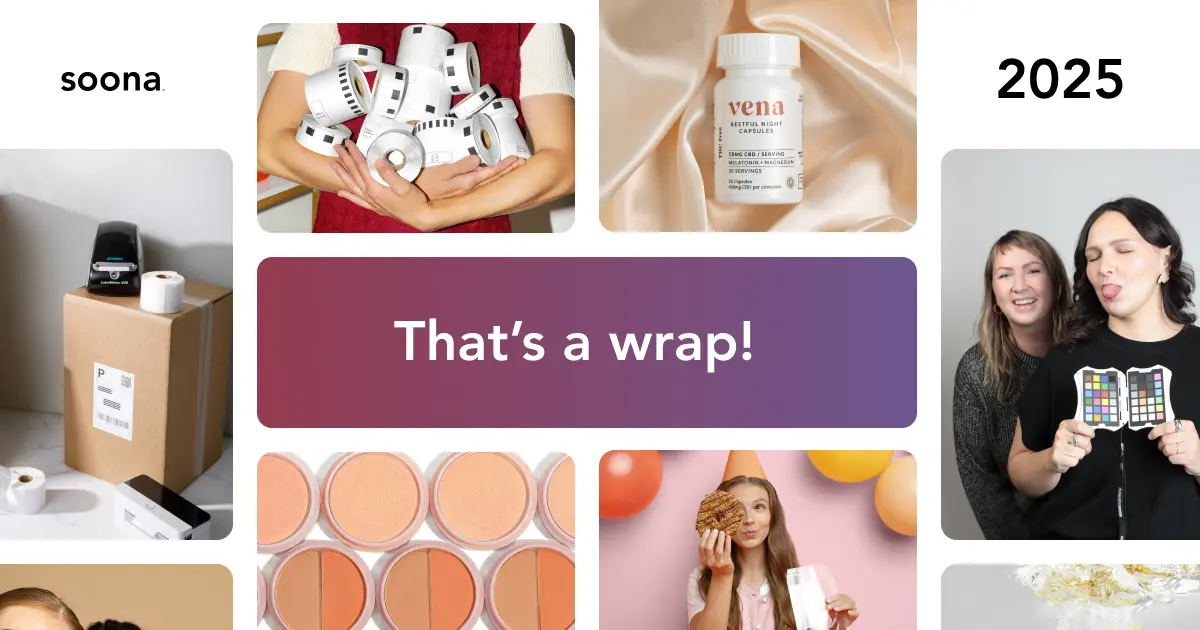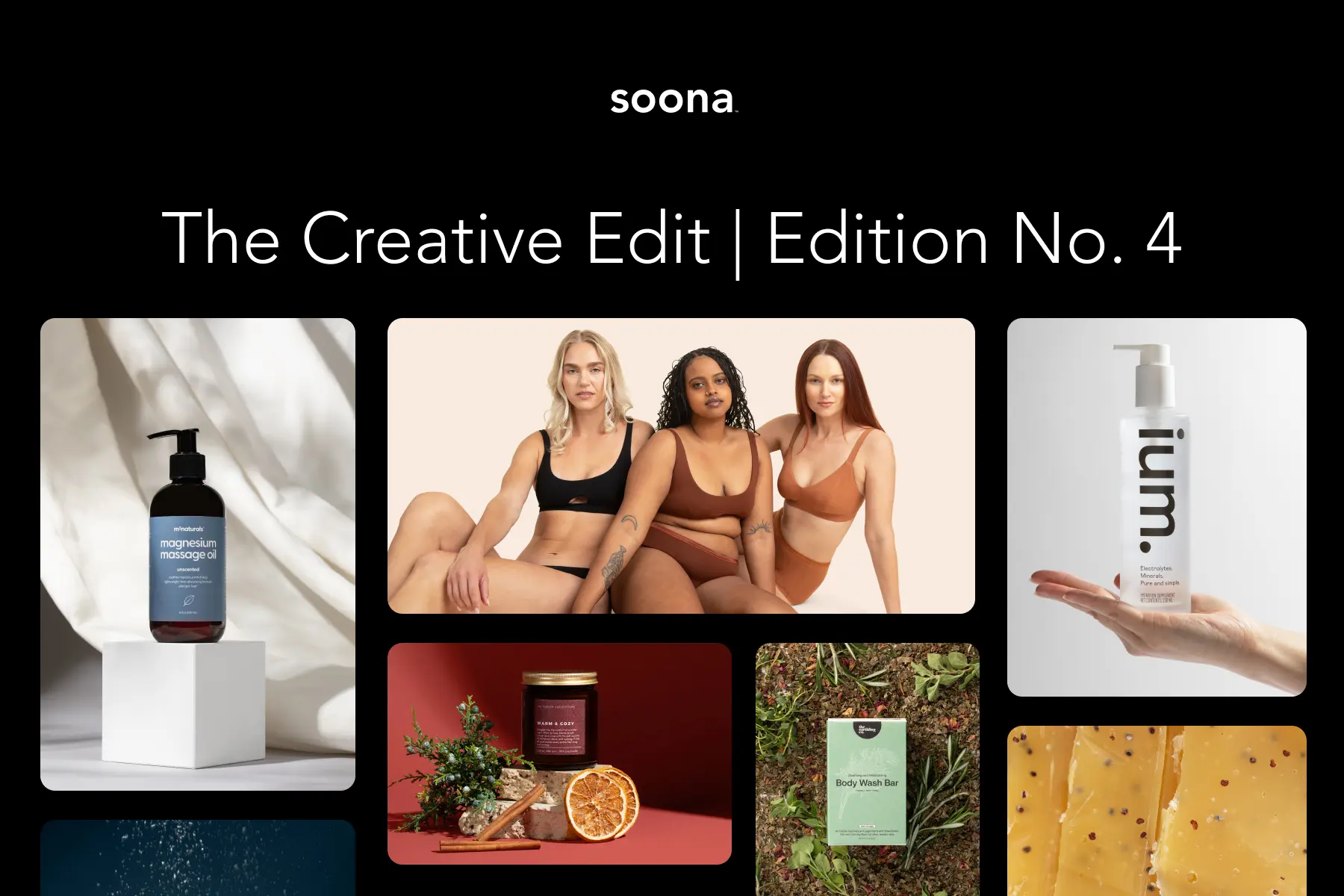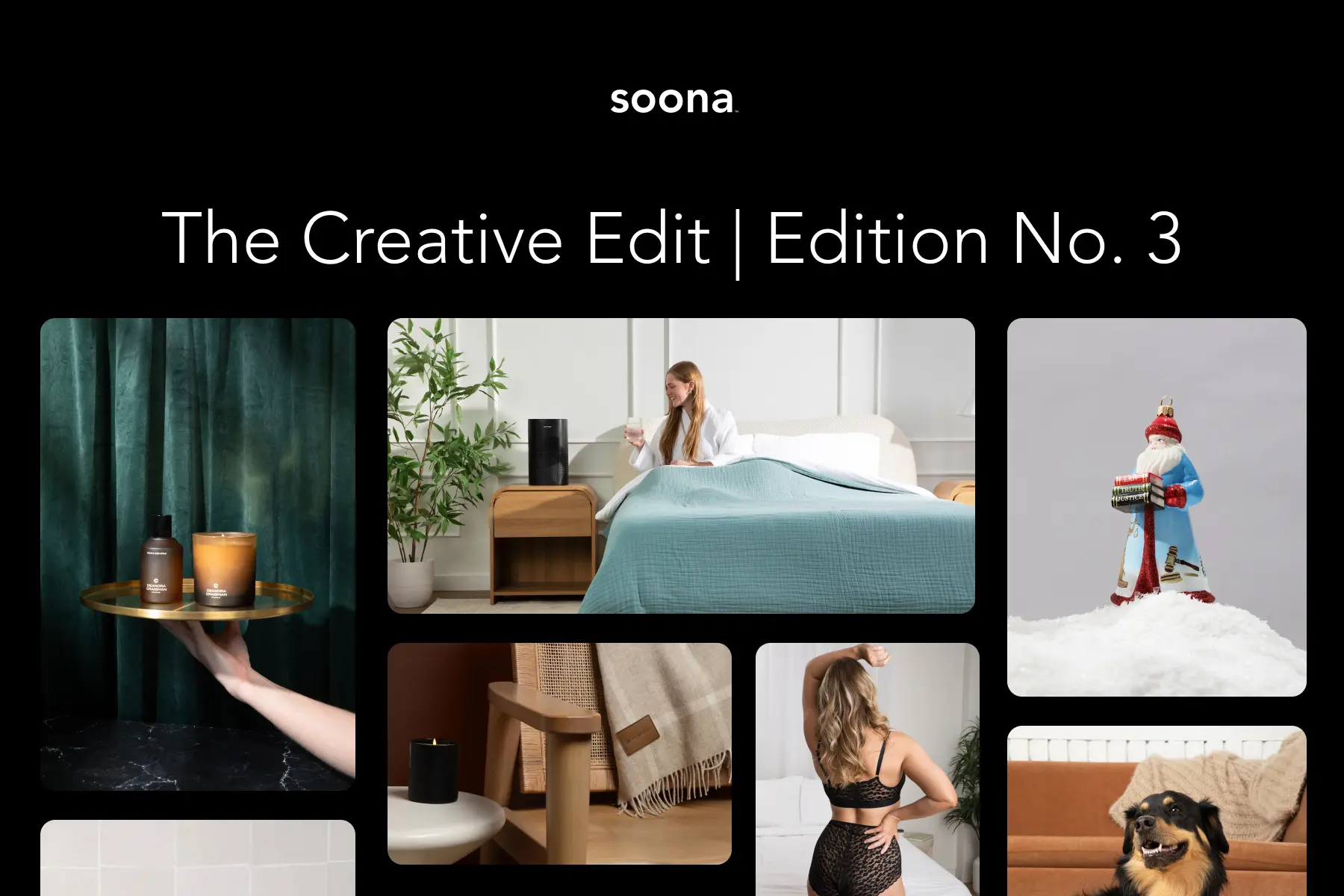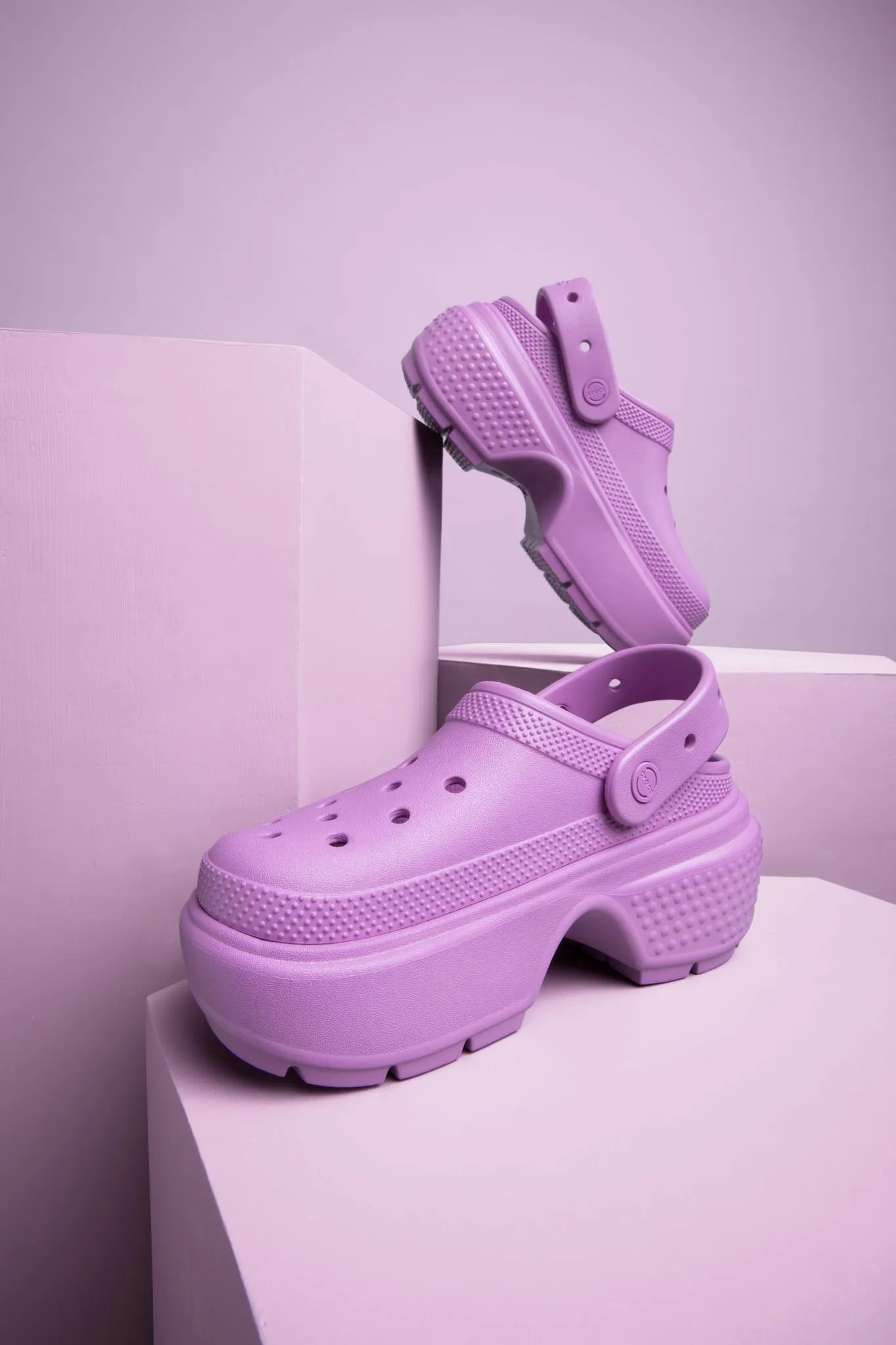Product styling is an essential aspect of product photography. It’s important whether you’re shooting content for product description pages, social media campaigns, or both! The way a product is presented to the public has a significant impact on how it’s perceived by potential customers. You need a product that stands out from the crowd, and product styling can help achieve this.
There’s a reason product styling is a whole profession in and of itself. Stylists are professionals who work behind the scenes to create visually appealing and cohesive looks for various industries. From fashion to food, stylists play a crucial role in ensuring that products and images are presented in the best possible light.
Not a product stylist yourself? Check out this post to find out how to style your shots to engage more shoppers—and how to enlist the help of pro styling services from a studio like soona.
What is product styling in photography?
Product styling is all about making a product look its best. You use lighting, props, and other tools to create an image that highlights the product’s features and benefits. This can be especially important for online sales, where the product image is the only thing the customer sees before making a purchase.

The role of styling in product photography
Styling is an art that requires creativity, attention to detail, and an understanding of the target audience. Styling can transform an ordinary product into something that stands out and catches the eye of potential customers. It can create a look that’s both appealing and relevant to the target market. When looking for a stylist, make sure to take a look at their portfolio of past work.

Product styling happens in shoots for advertising and marketing, creating images and videos that showcase products in the best possible light. It requires collaborating with photographers, videographers, and graphic designers to create visually appealing content that highlights the product’s features and benefits. You need an understanding of the target audience to be able to create images that resonate with them.
How to style product photos
You can tap into a range of techniques to create eye-catching visuals that sell, strategically arranging and presenting the product, props, and backgrounds to enhance visual appeal and highlight unique features. Pay close attention to color, texture, and composition to create an image that’s both aesthetically pleasing and informative.

1. Get to know your audience
Styling involves a lot of preparation, planning, and attention to detail. Spend a significant amount of time researching and understanding the brand, product, or concept. Analyze the target audience and the message that needs to be conveyed through the visuals.
2. Select your products
The product is the star of the shot, so it's important to identify which product(s) you need to showcase so you can build everything else around it.
3. Know the story you’re going to tell
Product styling can help create a narrative around the product, conveying a lifestyle or a specific use case that appeals to the target audience. This kind of storytelling helps a customer envision themselves with the product and can ultimately lead to a sale.
Keep the following in mind when determining the story you’re telling:
Highlight key features
Effective product styling can draw attention to the most important aspects of the product, showcasing its unique design elements, functionality, and benefits.
Create emotional connections
Styling can evoke emotions and create a connection between the product and the audience. By using appropriate colors, textures, and settings, the product can resonate with potential buyers on a deeper level.
Set the right mood
The styling choices, such as lighting and background, can set the mood of the photo or video. For example, a bright and airy setup might work well for a fresh and youthful product, while a darker and moody setup may suit a luxurious or sophisticated item.
4. Choose a background
Your product photography background might be a mandatory white if you’re shooting for a marketplace listing on Amazon, but if you want to use the photos elsewhere, you can get more creative here. Regardless, use a product photography background that supports your vision, highlights the product, and complements the styling.
5. Find props that complement your vision
Now you can begin the process of selecting the appropriate props, accessories, and clothing. Work closely with photographers and art directors to ensure everything fits together seamlessly.
6. Arrange the shot
Use techniques such as layering, grouping, and repetition to create a sense of depth and interest. Ultimately, the goal is to create an image that not only looks great, but also communicates the value of the product to potential customers.
Pay attention to the lighting, too. If you’re banking on using natural light, you’ll want to make sure you have each of the different angles right depending on the hour—remember, the sun moves throughout the day, so this will affect your shot.
7. Shoot the photos
Once you’re happy with the frame, the background, the props, the styling, and the lighting, you’re ready to shoot your shot. If you need some guidance on what it takes to make stunning product photos, you can check out this ultimate guide to product photography to get you started.
8. Edit your photos
While you can do as much as you can to make the shot perfect while on set, there’s still likely to be some post-production editing needs. Maybe you need to resize the photos for different platforms, or maybe you need to retouch a smudge or a wrinkle that wasn’t meant to be there. You can do this yourself or outsource it to a skilled team of professionals who already know Photoshop and marketplaces specs.
{{tools-ad}}
9. Repurpose your product content
There’s no reason to shoot product photos, post them in one place, and call it a day. The real ROI of product content comes into play when you optimize and repurpose your assets for other uses. Shooting white background shots for Amazon? Switch the background and use them on seasonal marketing materials.
Tips and best practices for product styling
Keep the following tips and best practices in mind when styling your product photos:
Be consistent and on-brand
A well-executed styling strategy ensures consistency in how the products are presented, aligning them with your brand identity and values across social media platforms and storefronts.
Showcase product scale and size
Styling can help provide a sense of scale, making it easier for customers to understand the product’s size and dimensions.
Attract attention on ecommerce platforms
On crowded ecommerce platforms, eye-catching product photos and videos stand a better chance of grabbing shoppers’ attention, leading to increased click-throughs and conversions.
Aim for versatility and adaptability
Skillful product styling allows for flexibility in how the product is presented, making it suitable for various marketing channels, including social media, websites, print materials, and more.
Eliminate distractions
Styling helps remove any distractions that could divert attention away from the product, ensuring that it remains the primary focus.
Encourage engagement
Unique and visually appealing product photos and videos are more likely to be shared and engaged with on social media, extending the product’s reach and visibility.
Industry- and niche-specific product photography styling
Food styling
Food styling requires an understanding of food preparation and presentation to be able to create images that make the viewer’s mouth water. It’s a specialized area of styling that focuses on making food look as appealing as possible.

Food stylists know how to use lighting, props, and other techniques to create an image that makes the food look delicious. This can be especially important for restaurants and food companies that rely on visual appeal to attract customers.
Food styling can also apply to beauty photography. Working with a food stylist can be beneficial when placing your beauty products with raw ingredients, freshly cut fruit, or vegetables. Bonus if you have a food stylist and a beauty stylist working together to create fresh swatches and placing fresh foods!
The goal is to make foods look appealing and appetizing for various media, including advertisements, cookbooks, magazines, and TV shows.
Food styling involves more than just arranging food on a plate. It requires a keen eye for detail, creativity, and a deep understanding of food and its properties. A food stylist must be able to choose the right ingredients, props, and lighting to create a visually appealing dish that looks as good as it tastes.
Some common tasks for food styling include:
- Choosing and preparing ingredients: Select fresh and high-quality ingredients that look good on camera (during the photo or video shoot). You may also need to cook or prepare the food to achieve the desired look, depending on the project.
- Plating and arranging food: Arrange the food on the plate in a visually appealing way. You may use techniques like stacking, layering, or garnishing to create a beautiful presentation.
- Selecting props and backgrounds: Choose the right props and backgrounds to complement the food. This can include plates, utensils, tablecloths, and other decorative items.
Fashion styling
In the fashion industry, fashion and clothing styling involves assisting brands, models, and photographers on fashion shoots. You’ll need to select clothing and accessories to showcase your vision and ensure the models look their best.
Fashion styling requires a keen eye for detail, a sense of style, and an understanding of current trends. Fashion and clothing styling is all about creating a look that sells. Fashion stylists know how to create an outfit that’s both stylish and practical, while clothing stylists focus on making clothes look their best. It includes the use of accessories, makeup, and other tools to create a look that appeals to the target market.
This also includes selecting clothing and accessories that complement the model’s body type and skin tone, as well as the overall theme of the shoot. Fashion stylists are also well versed in textiles and design to understand the components and functions of garments.
A fashion stylist might have to do the following:
- Create cohesive looks
- Steam or iron garments
- Fit clothing on models or mannequins
- Select accessories
- Make sure the articles of clothing are clean and presentable
- Coordinate with hair and makeup artists
- Create mood boards and style guides that are on trend
- Pin clothing on ghost mannequins
- Create flat lays with clothing, accessories, and props
Beauty styling
Beauty styling involves creating images and photos that showcase the texture, consistency, color, and benefits of beauty products. Beauty stylists are particularly skilled in swatching products on panels or models, arranging SKUs in an aesthetic manner, and pulling appropriate props.

A beauty stylist is essential to the success of a skincare and makeup brand looking to get eye-catching and scroll-stopping product images. This might include capturing swatches, the texture of products, detail shots, and packaging shots. Whether your brand is soft and minimalist, or bright with contrasting packaging, our beauty stylists know how to bring your brand vision to life.

The tasks of a beauty stylist vary depending on the project, but they generally include:
- Working with makeup and skincare companies to create visually appealing campaigns
- Selecting props and backdrops that complement the brand’s products
- Performing swatches and placing ingredients to showcase the brand’s products
- Collaborating with photographers and art directors
- Creating mood boards and style guides that are on trend
- Ensuring that the makeup, skincare products, and accessories are clean and in good condition
- Preparing the products for the shoot
- Preparing fresh ingredients to decorate scenes
soona knows style (and stylists!)
Stylists are an essential part of the creative industry, and their expertise and knowledge play a vital role in creating visually stunning and captivating images. Whether it’s fashion, product styling, commercial styling, food styling, or clothing styling, stylists bring a unique perspective and creative flair to every project they work on.
Enter soona! We have expert stylists who are well-versed and exceptionally talented in each industry. We know that they can help capture the quality of your product, and make your product photography POP!
{{studio-ad}}
Product photography styling FAQs
What qualifications do you need to become a fashion stylist?
To become a fashion stylist, you do not necessarily need a formal education. However, it can be helpful to have a degree in fashion design, fashion merchandising, or a related career field. Additionally, experience in the fashion industry, such as working in retail or interning with a fashion company, can be beneficial. If you’re a stylist located in Los Angeles, Denver, Austin or Minneapolis, and you’re interested in joining our soona collective, apply now to work in one of our studios!
How important is a fashion stylist in the fashion industry?
A fashion stylist is a crucial part of the fashion industry, as they are responsible for creating and executing the overall look and feel of a fashion shoot or runway show. They work closely with designers, photographers, and models to ensure that the clothing and accessories are showcased in the best possible way.
What are the essential tools for a fashion stylist?
Some essential tools for a fashion stylist include a well-stocked wardrobe, a variety of styling tools such as steamer, iron, and sewing kit, ghost mannequins, a good camera, and a laptop with free photo editing software. Additionally, having access to a network of contacts in the fashion industry can be helpful for sourcing clothing and accessories.
What is the cost to hire a stylist?
Depending on the industry, project, and stylist skill level the cost to hire a stylist can range from $600-$2500 for day rates. At soona, stylists start at $149 per hour and can be hired for 1 to 4 hour shoots. Hire your soona stylist today!
How do I know if I need a stylist?
Hiring a stylist is essential to bring your content vision to life. You’ll need a stylist when you have a unique and complex moodboard, shot list, and creative vision for your product photography. If you’re looking to showcase various props, fresh ingredients, or unique backdrops a stylist will also be needed. Lastly, stylists are a must when you’re looking to manipulate props and products in specific ways on set to recreate inspo photos or videos.
Are stylists creative directors?
While stylists are not creative directors, they support the customer and photographer execute the creative vision provided in moodboards, shotlists, and shoot goals. Stylists follow customers’ creative direction to set up scenes and capture your vision. stylists add an extra set of hands to your shoot + helps bring your vision to life.
Can a stylist select my props?
Yes! Stylists are often hand-selecting props specifically for your project. They ensure all props are photo-ready and fit your overall creative vision. At soona we offer a grocery shopping service for $79 + cost of goods to have a stylist source fresh ingredients and local props.
Product styling is an essential aspect of product photography. It’s important whether you’re shooting content for product description pages, social media campaigns, or both! The way a product is presented to the public has a significant impact on how it’s perceived by potential customers. You need a product that stands out from the crowd, and product styling can help achieve this.
There’s a reason product styling is a whole profession in and of itself. Stylists are professionals who work behind the scenes to create visually appealing and cohesive looks for various industries. From fashion to food, stylists play a crucial role in ensuring that products and images are presented in the best possible light.
Not a product stylist yourself? Check out this post to find out how to style your shots to engage more shoppers—and how to enlist the help of pro styling services from a studio like soona.
What is product styling in photography?
Product styling is all about making a product look its best. You use lighting, props, and other tools to create an image that highlights the product’s features and benefits. This can be especially important for online sales, where the product image is the only thing the customer sees before making a purchase.

The role of styling in product photography
Styling is an art that requires creativity, attention to detail, and an understanding of the target audience. Styling can transform an ordinary product into something that stands out and catches the eye of potential customers. It can create a look that’s both appealing and relevant to the target market. When looking for a stylist, make sure to take a look at their portfolio of past work.

Product styling happens in shoots for advertising and marketing, creating images and videos that showcase products in the best possible light. It requires collaborating with photographers, videographers, and graphic designers to create visually appealing content that highlights the product’s features and benefits. You need an understanding of the target audience to be able to create images that resonate with them.
How to style product photos
You can tap into a range of techniques to create eye-catching visuals that sell, strategically arranging and presenting the product, props, and backgrounds to enhance visual appeal and highlight unique features. Pay close attention to color, texture, and composition to create an image that’s both aesthetically pleasing and informative.

1. Get to know your audience
Styling involves a lot of preparation, planning, and attention to detail. Spend a significant amount of time researching and understanding the brand, product, or concept. Analyze the target audience and the message that needs to be conveyed through the visuals.
2. Select your products
The product is the star of the shot, so it's important to identify which product(s) you need to showcase so you can build everything else around it.
3. Know the story you’re going to tell
Product styling can help create a narrative around the product, conveying a lifestyle or a specific use case that appeals to the target audience. This kind of storytelling helps a customer envision themselves with the product and can ultimately lead to a sale.
Keep the following in mind when determining the story you’re telling:
Highlight key features
Effective product styling can draw attention to the most important aspects of the product, showcasing its unique design elements, functionality, and benefits.
Create emotional connections
Styling can evoke emotions and create a connection between the product and the audience. By using appropriate colors, textures, and settings, the product can resonate with potential buyers on a deeper level.
Set the right mood
The styling choices, such as lighting and background, can set the mood of the photo or video. For example, a bright and airy setup might work well for a fresh and youthful product, while a darker and moody setup may suit a luxurious or sophisticated item.
4. Choose a background
Your product photography background might be a mandatory white if you’re shooting for a marketplace listing on Amazon, but if you want to use the photos elsewhere, you can get more creative here. Regardless, use a product photography background that supports your vision, highlights the product, and complements the styling.
5. Find props that complement your vision
Now you can begin the process of selecting the appropriate props, accessories, and clothing. Work closely with photographers and art directors to ensure everything fits together seamlessly.
6. Arrange the shot
Use techniques such as layering, grouping, and repetition to create a sense of depth and interest. Ultimately, the goal is to create an image that not only looks great, but also communicates the value of the product to potential customers.
Pay attention to the lighting, too. If you’re banking on using natural light, you’ll want to make sure you have each of the different angles right depending on the hour—remember, the sun moves throughout the day, so this will affect your shot.
7. Shoot the photos
Once you’re happy with the frame, the background, the props, the styling, and the lighting, you’re ready to shoot your shot. If you need some guidance on what it takes to make stunning product photos, you can check out this ultimate guide to product photography to get you started.
8. Edit your photos
While you can do as much as you can to make the shot perfect while on set, there’s still likely to be some post-production editing needs. Maybe you need to resize the photos for different platforms, or maybe you need to retouch a smudge or a wrinkle that wasn’t meant to be there. You can do this yourself or outsource it to a skilled team of professionals who already know Photoshop and marketplaces specs.
{{tools-ad}}
9. Repurpose your product content
There’s no reason to shoot product photos, post them in one place, and call it a day. The real ROI of product content comes into play when you optimize and repurpose your assets for other uses. Shooting white background shots for Amazon? Switch the background and use them on seasonal marketing materials.
Tips and best practices for product styling
Keep the following tips and best practices in mind when styling your product photos:
Be consistent and on-brand
A well-executed styling strategy ensures consistency in how the products are presented, aligning them with your brand identity and values across social media platforms and storefronts.
Showcase product scale and size
Styling can help provide a sense of scale, making it easier for customers to understand the product’s size and dimensions.
Attract attention on ecommerce platforms
On crowded ecommerce platforms, eye-catching product photos and videos stand a better chance of grabbing shoppers’ attention, leading to increased click-throughs and conversions.
Aim for versatility and adaptability
Skillful product styling allows for flexibility in how the product is presented, making it suitable for various marketing channels, including social media, websites, print materials, and more.
Eliminate distractions
Styling helps remove any distractions that could divert attention away from the product, ensuring that it remains the primary focus.
Encourage engagement
Unique and visually appealing product photos and videos are more likely to be shared and engaged with on social media, extending the product’s reach and visibility.
Industry- and niche-specific product photography styling
Food styling
Food styling requires an understanding of food preparation and presentation to be able to create images that make the viewer’s mouth water. It’s a specialized area of styling that focuses on making food look as appealing as possible.

Food stylists know how to use lighting, props, and other techniques to create an image that makes the food look delicious. This can be especially important for restaurants and food companies that rely on visual appeal to attract customers.
Food styling can also apply to beauty photography. Working with a food stylist can be beneficial when placing your beauty products with raw ingredients, freshly cut fruit, or vegetables. Bonus if you have a food stylist and a beauty stylist working together to create fresh swatches and placing fresh foods!
The goal is to make foods look appealing and appetizing for various media, including advertisements, cookbooks, magazines, and TV shows.
Food styling involves more than just arranging food on a plate. It requires a keen eye for detail, creativity, and a deep understanding of food and its properties. A food stylist must be able to choose the right ingredients, props, and lighting to create a visually appealing dish that looks as good as it tastes.
Some common tasks for food styling include:
- Choosing and preparing ingredients: Select fresh and high-quality ingredients that look good on camera (during the photo or video shoot). You may also need to cook or prepare the food to achieve the desired look, depending on the project.
- Plating and arranging food: Arrange the food on the plate in a visually appealing way. You may use techniques like stacking, layering, or garnishing to create a beautiful presentation.
- Selecting props and backgrounds: Choose the right props and backgrounds to complement the food. This can include plates, utensils, tablecloths, and other decorative items.
Fashion styling
In the fashion industry, fashion and clothing styling involves assisting brands, models, and photographers on fashion shoots. You’ll need to select clothing and accessories to showcase your vision and ensure the models look their best.
Fashion styling requires a keen eye for detail, a sense of style, and an understanding of current trends. Fashion and clothing styling is all about creating a look that sells. Fashion stylists know how to create an outfit that’s both stylish and practical, while clothing stylists focus on making clothes look their best. It includes the use of accessories, makeup, and other tools to create a look that appeals to the target market.
This also includes selecting clothing and accessories that complement the model’s body type and skin tone, as well as the overall theme of the shoot. Fashion stylists are also well versed in textiles and design to understand the components and functions of garments.
A fashion stylist might have to do the following:
- Create cohesive looks
- Steam or iron garments
- Fit clothing on models or mannequins
- Select accessories
- Make sure the articles of clothing are clean and presentable
- Coordinate with hair and makeup artists
- Create mood boards and style guides that are on trend
- Pin clothing on ghost mannequins
- Create flat lays with clothing, accessories, and props
Beauty styling
Beauty styling involves creating images and photos that showcase the texture, consistency, color, and benefits of beauty products. Beauty stylists are particularly skilled in swatching products on panels or models, arranging SKUs in an aesthetic manner, and pulling appropriate props.

A beauty stylist is essential to the success of a skincare and makeup brand looking to get eye-catching and scroll-stopping product images. This might include capturing swatches, the texture of products, detail shots, and packaging shots. Whether your brand is soft and minimalist, or bright with contrasting packaging, our beauty stylists know how to bring your brand vision to life.

The tasks of a beauty stylist vary depending on the project, but they generally include:
- Working with makeup and skincare companies to create visually appealing campaigns
- Selecting props and backdrops that complement the brand’s products
- Performing swatches and placing ingredients to showcase the brand’s products
- Collaborating with photographers and art directors
- Creating mood boards and style guides that are on trend
- Ensuring that the makeup, skincare products, and accessories are clean and in good condition
- Preparing the products for the shoot
- Preparing fresh ingredients to decorate scenes
soona knows style (and stylists!)
Stylists are an essential part of the creative industry, and their expertise and knowledge play a vital role in creating visually stunning and captivating images. Whether it’s fashion, product styling, commercial styling, food styling, or clothing styling, stylists bring a unique perspective and creative flair to every project they work on.
Enter soona! We have expert stylists who are well-versed and exceptionally talented in each industry. We know that they can help capture the quality of your product, and make your product photography POP!
{{studio-ad}}
Product photography styling FAQs
What qualifications do you need to become a fashion stylist?
To become a fashion stylist, you do not necessarily need a formal education. However, it can be helpful to have a degree in fashion design, fashion merchandising, or a related career field. Additionally, experience in the fashion industry, such as working in retail or interning with a fashion company, can be beneficial. If you’re a stylist located in Los Angeles, Denver, Austin or Minneapolis, and you’re interested in joining our soona collective, apply now to work in one of our studios!
How important is a fashion stylist in the fashion industry?
A fashion stylist is a crucial part of the fashion industry, as they are responsible for creating and executing the overall look and feel of a fashion shoot or runway show. They work closely with designers, photographers, and models to ensure that the clothing and accessories are showcased in the best possible way.
What are the essential tools for a fashion stylist?
Some essential tools for a fashion stylist include a well-stocked wardrobe, a variety of styling tools such as steamer, iron, and sewing kit, ghost mannequins, a good camera, and a laptop with free photo editing software. Additionally, having access to a network of contacts in the fashion industry can be helpful for sourcing clothing and accessories.
What is the cost to hire a stylist?
Depending on the industry, project, and stylist skill level the cost to hire a stylist can range from $600-$2500 for day rates. At soona, stylists start at $149 per hour and can be hired for 1 to 4 hour shoots. Hire your soona stylist today!
How do I know if I need a stylist?
Hiring a stylist is essential to bring your content vision to life. You’ll need a stylist when you have a unique and complex moodboard, shot list, and creative vision for your product photography. If you’re looking to showcase various props, fresh ingredients, or unique backdrops a stylist will also be needed. Lastly, stylists are a must when you’re looking to manipulate props and products in specific ways on set to recreate inspo photos or videos.
Are stylists creative directors?
While stylists are not creative directors, they support the customer and photographer execute the creative vision provided in moodboards, shotlists, and shoot goals. Stylists follow customers’ creative direction to set up scenes and capture your vision. stylists add an extra set of hands to your shoot + helps bring your vision to life.
Can a stylist select my props?
Yes! Stylists are often hand-selecting props specifically for your project. They ensure all props are photo-ready and fit your overall creative vision. At soona we offer a grocery shopping service for $79 + cost of goods to have a stylist source fresh ingredients and local props.



